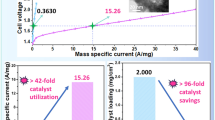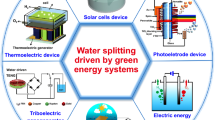Abstract
A low-cost porous polypropylene membrane has been employed as the diaphragm for CO2 electro-reduction in H-type electrolysis cell in organic electrolyte. Compared with the commonly used Nafion membrane, porous polypropylene exhibits many advantages, such as low cost, low ionic transport resistance, high Faradaic efficiency, low cell voltage, and high energy efficiency. The ionic transport mechanism in polypropylene membrane has been investigated: owing to the presence of interconnected sponge-like in the membrane, and due to the hydrophobic nature of polypropylene, only organic solution can enter into the pore of the polypropylene membrane. As a consequence, an organic/aqueous liquid–liquid interface is formed on the anode side. During the electrolysis process, H2O is oxidized at the anode. The generated protons transfer through the liquid–liquid interface and diffuse to the cathode to take part in CO2 electro-reduction reaction. Because the cost of polypropylene membrane is cheap, it has a promising perspective in practical utilization.




Similar content being viewed by others
References
Wu M, Liao J, Yu L, Lv R, Li P, Sun W et al (2020) 2020 Roadmap on carbon materials for energy storage and conversion. Chem Asian J 15:995–1013
Su DS (2012) Editorial: chemistry of energy conversion and storage. ChemSusChem 5:443–445
Islam MR, Guo Y, Zhu J (2014) A review of offshore wind turbine nacelle: technical challenges, and research and developmental trends. Renew Sustain Energy Rev 33:161–176
Rourke FO, Boyle F, Reynolds A (2010) Tidal energy update 2009. Appl Energy 87:398–409
Singh GK (2013) Solar power generation by PV (photovoltaic) technology: a review. Energy 53:1–13
Albo J, Alvarez-Guerra M, Castaño P, Irabien A (2015) Towards the electrochemical conversion of carbon dioxide into methanol. Green Chem 17:2304–2324
Merino-Garcia I, Albo J, Irabien A (2018) Tailoring gas-phase CO2 electroreduction selectivity to hydrocarbons at Cu nanoparticles. Nanotechnology 29:014001
Kibria MG, Edwards JP, Gabardo CM, Dinh CT, Seifitokaldani A, Sinton D et al (2019) Electrochemical CO2 reduction into chemical feedstocks: from mechanistic electrocatalysis models to system design. Adv Mater 31:e1807166
Han L, Song S, Liu M, Yao S, Liang Z, Cheng H et al (2020) Stable and efficient single-atom Zn catalyst for CO2 reduction to CH4. J Am Chem Soc 142:12563–12567
Albo J, Beobide G, Castaño P, Irabien A (2017) Methanol electrosynthesis from CO2 at Cu2O/ZnO prompted by pyridine-based aqueous solutions. J CO2 Util 18:164–172
Albo J, Irabien A (2016) Cu2O-loaded gas diffusion electrodes for the continuous electrochemical reduction of CO2 to methanol. J Catal 343:232–239
Merino-Garcia Ivan, Albo Jonathan, Irabien Angel (2017) Productivity and selectivity of gas-phase CO2 electroreduction to methane at copper nanoparticle-based electrodes. Energy Technol 5:922–8
Centi G, Perathoner S (2009) Opportunities and prospects in the chemical recycling of carbon dioxide to fuels. Catal Today 148:191–205
Centi G, Quadrelli EA, Perathoner S (2013) Catalysis for CO2 conversion: a key technology for rapid introduction of renewable energy in the value chain of chemical industries. Energy Environ Sci 6:1711
Hori Y (2008) Electrochemical CO2 reduction on metal electrodes. Springer, New York, 42:89-189
Dubois MR, Dubois DL (2009) Development of molecular electrocatalysts for CO2 reduction and H2 production/oxidation. Acc Chem Res 42:1974–1982
Kong Z, Li L, Wang T, Rong C, Xue Y, Zhang T et al (2020) New insights into the cultivation of N,N-dimethylformamide-degrading methanogenic consortium: a long-term investigation on the variation of prokaryotic community inoculated with activated sludge. Environ Res 182:109060
Lozinsky VI, Leonova IM, Ivanov RV, Bakeeva IV (2017) A study of cryostructuring of polymer systems. 46. Physicochemical properties and microstructure of poly(vinyl alcohol) cryogels formed from polymer solutions in mixtures of dimethyl sulfoxide with low-molecular-mass alcohols. Colloid J 79:788–96
Izutsu K, Kolthoff IM, Fujinaga T, Hattori M, Chantooni MK (1977) Base equilibria of some acids in propylene carbonate. Anal Chem 49:503–8
Eneau-Innocent B, Pasquier D, Ropital F, Léger JM, Kokoh KB (2010) Electroreduction of carbon dioxide at a lead electrode in propylene carbonate: a spectroscopic study. Appl Catal B 98:65–71
Murrieta-Guevara F, Rodriguez AT (1984) Solubility of carbon dioxide, hydrogen sulfide, and methane in pure and mixed solvents. J Chem Eng 29:456–60
Alvarez-Guerra M, Albo J, Alvarez-Guerra E, Irabien A (2015) Ionic liquids in the electrochemical valorisation of CO2. Energy Environ Sci 8:2574–2599
Rosen BA, Zhu W, Kaul G, Salehi-Khojin A, Masel RI (2012) Water enhancement of CO2 conversion on silver in 1-ethyl-3-methylimidazolium tetrafluoroborate. J Electrochem Soc 160:H138–H141
Rosen BA, Salehi-Khojin A, Thorson MR, Zhu W, Whipple DT, Kenis PJA, Masel RI (2011) Ionic liquid-mediated selective conversion of CO2 to CO at low overpotentials. Science 334:643–4
Oh Y, Hu X (2013) Organic molecules as mediators and catalysts for photocatalytic and electrocatalytic CO2 reduction. Chem Soc Rev 42:2253–2261
House HO, Feng E, Peet NP (1971) A comparison of various tetraalkylammonium salts as supporting electrolytes in organic electrochemical reactions. J Organic Chem 36:2371–5
Shi J, Li Q-Y, Shi F, Song N, Jia Y-J, Hu Y-Q et al (2016) Design of a two-compartment electrolysis cell for the reduction of CO2 to CO in tetrabutylammonium perchlorate/propylene carbonate for renewable electrical energy storage. J Electrochem Soc 163:G82–G87
Kreuer KD (2001) On the development of proton conducting polymer membranes for hydrogen and methanol fuel cells. J Membr Sci 185:29–39
Song JY, Wang YY, Wan CC (1999) Review of gel-type polymer electrolytes for lithium-ion batteries. J Power Sources 77:183–97
Lee H, Yanilmaz M, Toprakci O, Fu K, Zhang X (2014) A review of recent developments in membrane separators for rechargeable lithium-ion batteries. Energy Environ Sci 7:3857–3886
Huang X (2010) Separator technologies for lithium-ion batteries. J Solid State Electrochem 15:649–662
Xia Z, Qiu W, Bao H, Yang B, Lei L, Zhikang X, Li Z (2016) Electrochemical reduction of gaseous CO2 with a catechol and polyethyleneimine co-deposited polypropylene membrane. Electrochem Commun 71:1–4. https://doi.org/10.1016/j.elecom.2016.07.009
Yang D-R, Liu L, Zhang Q, Shi Y, Zhou Y, Liu C et al (2020) Importance of Au nanostructures in CO2 electrochemical reduction reaction. Sci Bull 65:796–802
Andrews E, Katla S, Kumar C, Patterson M, Sprunger P, Flake J (2015) Electrocatalytic reduction of CO2 at Au nanoparticle electrodes: effects of interfacial chemistry on reduction behavior. J Electrochem Soc 162:F1373–F1378
Arora P, Zhang ZJ (2004) Battery separators. Chem Rev 104(10):4419–4462. https://doi.org/10.1021/cr020738u
Lee H, Alcoutlabi M, Toprakci O, Xu G, Watson JV, Zhang X (2014) Preparation and characterization of electrospun nanofiber-coated membrane separators for lithium-ion batteries. J Solid State Electrochem 18:2451–2458
Cho T-H, Tanaka M, Ohnishi H, Kondo Y, Yoshikazu M, Nakamura T et al (2010) Composite nonwoven separator for lithium-ion battery: development and characterization. J Power Sources 195:4272–4277
Mauritz KA, Moore RB (2004) State of understanding of Nafion. Chem Rev 104:4535–86
Kreuer K-D, Paddison SJ, Spohr E, Schuster M (2004) Transport in proton conductors for fuel-cell applications: simulations, elementary reactions, and phenomenology. Chem Rev 104:4637–78
Shi J, Chen T-Y, Shi F, Shen F-X, Dai Y-N, Yang B et al (2018) Non-membrane electrolysis cell for CO2 reduction to CO in propylene carbonate/tetrabutylammonium perchlorate. J Electrochem Soc 165:G51–G55
Gregory SB, Torsten R, Raguse B (2002) Energy storage by the electrochemical reduction of CO2 a porous Au film. J Electroanal Chem 526:125–33
Salvatore DA, Weekes DM, He J, Dettelbach KE, Li YC, Mallouk TE et al (2017) Electrolysis of gaseous CO2 to CO in a flow cell with a bipolar membrane. ACS Energy Lett 3:149–154
Endrődi B, Bencsik G, Darvas F, Jones R, Rajeshwar K, Janáky C (2017) Continuous-flow electroreduction of carbon dioxide. Prog Energy Combust Sci 62:133–154
Hu S, Zhang L, Liu H, Cao Z, Yu W, Zhu X et al (2019) Alkaline-earth elements (Ca, Sr and Ba) doped LaFeO3-δ cathodes for CO2 electroreduction. J Power Sources 443:227268
Song Y, Zhang X, Zhou Y, Lv H, Liu Q, Feng W et al (2019) Improving the performance of solid oxide electrolysis cell with gold nanoparticles-modified LSM-YSZ anode. J Energy Chem 35:181–187
Tan X, Yu C, Ren Y, Cui S, Li W, Qiu J (2021) Recent advances in innovative strategies for the CO2 electroreduction reaction. Energy Environ Sci 14:765–780
Tufa RA, Chanda D, Ma M, Aili D, Demissie TB, Vaes J et al (2020) Towards highly efficient electrochemical CO2 reduction: cell designs, membranes and electrocatalysts. Appl Energy 277:115557
Acknowledgements
We gratefully acknowledge financial support from the National Natural Science Foundation of China (NSFC 52067012, U1802256) and the Analysis and Testing Foundation of Kunming University of Science and Technology (2020P20191130003).
Author information
Authors and Affiliations
Corresponding authors
Additional information
Publisher's note
Springer Nature remains neutral with regard to jurisdictional claims in published maps and institutional affiliations.
Supplementary Information
Below is the link to the electronic supplementary material.
Rights and permissions
About this article
Cite this article
Chen, Ty., Hu, J., Wang, Kz. et al. Porous polypropylene membrane for CO2 electro-reduction in organic medium. Ionics 27, 3639–3645 (2021). https://doi.org/10.1007/s11581-021-04134-6
Received:
Revised:
Accepted:
Published:
Issue Date:
DOI: https://doi.org/10.1007/s11581-021-04134-6




